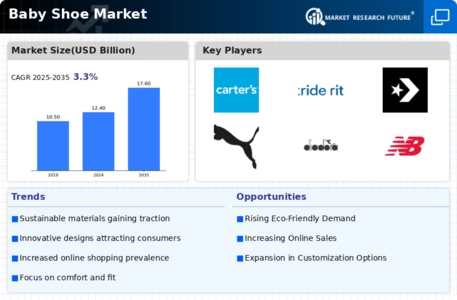The Baby Shoe Market is currently characterized by a dynamic competitive landscape, driven by a confluence of innovation, sustainability, and digital transformation. Major players such as Nike (US), Adidas (DE), and Stride Rite (US) are strategically positioning themselves to capture market share through various operational focuses. Nike (US) emphasizes innovation in design and technology, while Adidas (DE) is increasingly investing in sustainable materials and practices. Stride Rite (US), known for its focus on developmental footwear, is enhancing its product offerings to cater to health-conscious parents. Collectively, these strategies not only shape the competitive environment but also reflect a broader trend towards consumer-centric approaches in the baby shoe segment.
In terms of business tactics, companies are increasingly localizing manufacturing to reduce lead times and enhance supply chain efficiency. This trend appears to be a response to the growing demand for quick delivery and customization options. The market structure is moderately fragmented, with several key players exerting influence, yet the presence of niche brands like See Kai Run (US) and Robeez (US) adds complexity to the competitive dynamics. These smaller entities often focus on unique selling propositions, such as organic materials or specialized designs, which can disrupt traditional market players.
In August 2025, Nike (US) announced the launch of its new line of eco-friendly baby shoes, utilizing recycled materials and sustainable production methods. This strategic move not only aligns with the growing consumer demand for environmentally responsible products but also positions Nike as a leader in sustainability within the baby footwear segment. The initiative is likely to enhance brand loyalty among eco-conscious consumers, thereby strengthening its market position.
Similarly, in September 2025, Adidas (DE) unveiled a partnership with a leading technology firm to integrate AI-driven customization options into their baby shoe offerings. This collaboration aims to provide personalized fitting solutions, enhancing customer experience and potentially increasing sales. The integration of advanced technology into product offerings reflects a broader trend towards digitalization in the industry, suggesting that companies that leverage technology effectively may gain a competitive edge.
In October 2025, Stride Rite (US) expanded its distribution channels by entering into a strategic alliance with a prominent online retailer. This partnership is expected to enhance Stride Rite's visibility and accessibility, particularly among tech-savvy parents who prefer online shopping. Such strategic alliances are becoming increasingly vital in the current market, as they allow companies to tap into new customer bases and adapt to changing consumer behaviors.
As of October 2025, the Baby Shoe Market is witnessing significant trends such as digitalization, sustainability, and the integration of AI technologies. These trends are reshaping the competitive landscape, with companies increasingly forming strategic alliances to enhance their market presence. The shift from price-based competition to a focus on innovation, technology, and supply chain reliability is evident. Moving forward, differentiation will likely hinge on the ability to innovate and respond to consumer preferences, suggesting that companies must remain agile and forward-thinking to thrive in this evolving market.


















Leave a Comment